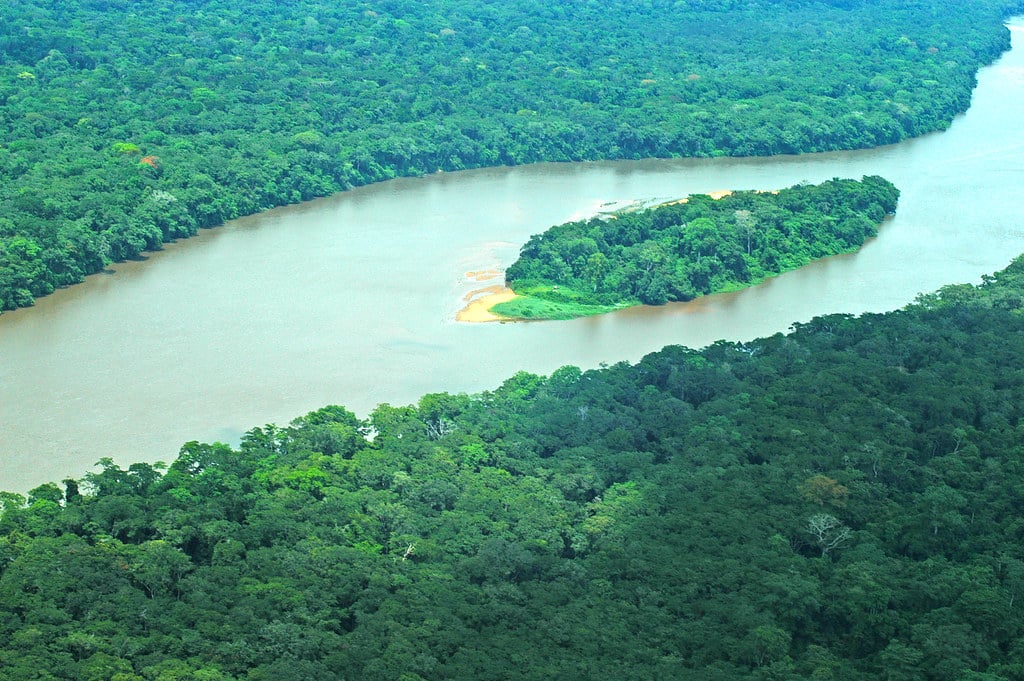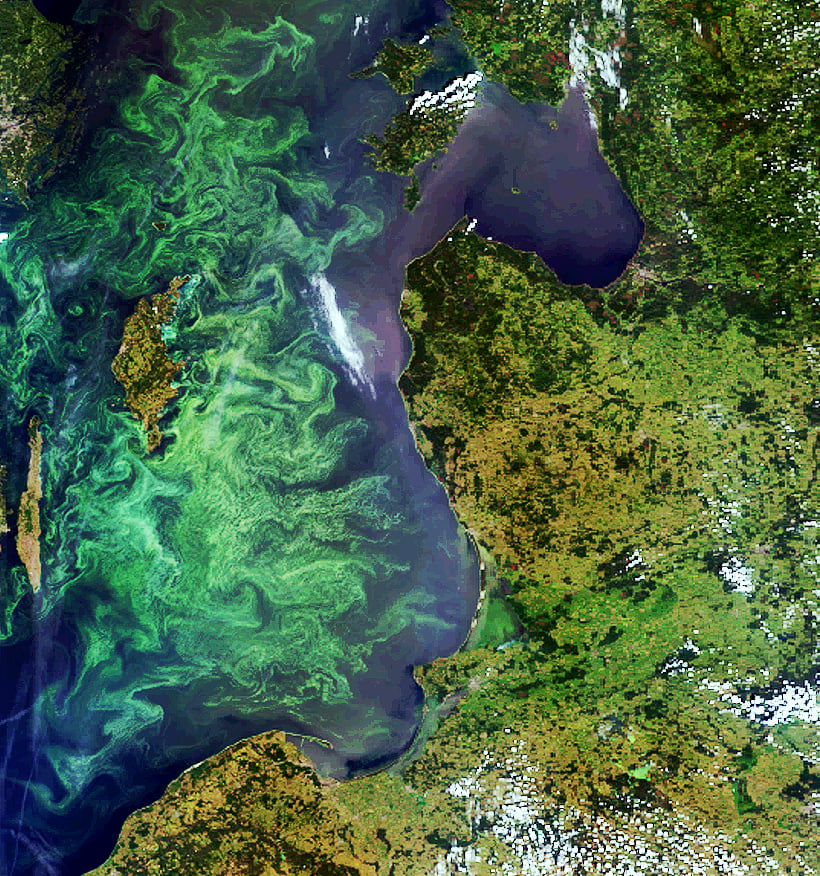Support strong Canadian climate journalism for 2025
This story was originally published by The Guardian and appears here as part of the Climate Desk collaboration.
It begins each day at nightfall. As the light disappears, billions of zooplankton, crustaceans and other marine organisms rise to the ocean surface to feed on microscopic algae, returning to the depths at sunrise. The waste from this frenzy – Earth’s largest migration of creatures – sinks to the ocean floor, removing millions of tonnes of carbon from the atmosphere each year.
This activity is one of thousands of natural processes that regulate the Earth’s climate. Together, the planet’s oceans, forests, soils and other natural carbon sinks absorb about half of all human emissions.
But as the Earth heats up, scientists are increasingly concerned that those crucial processes are breaking down.
In 2023, the hottest year ever recorded, preliminary findings by an international team of researchers show the amount of carbon absorbed by land has temporarily collapsed. The final result was that forest, plants and soil – as a net category – absorbed almost no carbon.
There are warning signs at sea, too. Greenland’s glaciers and Arctic ice sheets are melting faster than expected, which is disrupting the Gulf Stream ocean current and slows the rate at which oceans absorb carbon. For the algae-eating zooplankton, melting sea ice is exposing them to more sunlight – a shift scientists say could keep them in the depths for longer, disrupting the vertical migration that stores carbon on the ocean floor.
“We’re seeing cracks in the resilience of the Earth’s systems. We’re seeing massive cracks on land – terrestrial ecosystems are losing their carbon store and carbon uptake capacity, but the oceans are also showing signs of instability,” Johan Rockström, director of the Potsdam Institute for Climate Impact Research, told an event at New York Climate Week in September.
“Nature has so far balanced our abuse. This is coming to an end,” he said.
The 2023 breakdown of the land carbon sink could be temporary: without the pressures of drought or wildfires, land would return to absorbing carbon again. But it demonstrates the fragility of these ecosystems, with massive implications for the climate crisis.
Reaching net zero is impossible without nature. In the absence of technology that can remove atmospheric carbon on a large scale, the Earth’s vast forests, grasslands, peat bogs and oceans are the only option for absorbing human carbon pollution, which reached a record 37.4bn tonnes in 2023.
At least 118 countries are relying on the land to meet national climate targets. But rising temperatures, increased extreme weather and droughts are pushing the ecosystems into uncharted territory.
The kind of rapid land sink collapse seen in 2023 has not been factored into most climate models. If it continues, it raises the prospect of rapid global heating beyond what those models have predicted.
‘We have been lulled – we cannot see the crisis’
For the past 12,000 years, the Earth’s climate has existed in a fragile equilibrium. Its stable weather patterns allowed the development of modern agriculture, which now supports a population of more than 8 billion people.
As human emissions rose, the amount absorbed by nature increased too: higher carbon dioxide can mean plants grow faster, storing more carbon. But this balance is beginning to shift, driven by rising heat.
“This stressed planet has been silently helping us and allowing us to shove our debt under the carpet thanks to biodiversity,” says Rockström. “We are lulled into a comfort zone – we cannot really see the crisis.”

Only one major tropical rainforest – the Congo basin – remains a strong carbon sink that removes more than it releases into the atmosphere. Exacerbated by El Niño weather patterns, deforestation and global heating, the Amazon basin is experiencing a record-breaking drought, with rivers at an all-time low. Expansion of agriculture has turned tropical rainforests in south-east Asia into a net source of emissions in recent years.
Emissions from soil – which is the second-largest active carbon store after the oceans – are expected to increase by as much as 40% by the end of the century if they continue at the current rate, as soils become drier and microbes break them down faster.
Tim Lenton, professor of climate change and Earth system science at Exeter University, says: “We are seeing in the biosphere some surprising responses that are not what got predicted, just as we are in the climate.
“You have to question: to what degree can we rely on them as carbon sinks or carbon stores?” he says.
A paper published in July found that while the total amount of carbon absorbed by forests between 1990 and 2019 was steady, it varied substantially by region. The boreal forests – home to about a third of all carbon found on land, which stretch across Russia, Scandinavia, Canada and Alaska – have seen a sharp fall in the amount of carbon they absorb, down more than a third due to climate crisis-related beetle outbreaks, fire and clearing for timber.
Combined with the declining resilience of the Amazon and drought conditions in parts of the tropics, the hot conditions in the northern forests helped drive the collapse of the land sink in 2023 – causing a spike in the rate of atmospheric carbon.
“In 2023 the accumulation of CO2 in the atmosphere is very high and this translates into a very, very low absorption by the terrestrial biosphere,” says Philippe Ciais, a researcher at the French Laboratory of Climate and Environmental Sciences, who was an author of the most recent paper.
“In the northern hemisphere, where you have more than half of CO2 uptake, we have seen a decline trend in absorption for eight years,” he says. “There is no good reason to believe it will bounce back.”
The oceans – nature’s largest absorber of CO2 – have soaked up 90% of the warming from fossil fuels in recent decades, driving a rise in sea temperatures. Studies have also found signs that this is weakening the ocean carbon sink.
‘None of the models have factored this in’
The flow of carbon through the land and ocean remains one of the least understood parts of climate science, say researchers. While human emissions are increasingly simple to measure, the sheer number and complexity of processes in the natural world mean there are important gaps in our understanding.
Satellite technology has improved monitoring of forests, peatlands, permafrost and ocean cycles, but assessments and forecasts in international reports often have large error margins. That makes it difficult to predict how the world’s natural carbon sinks will behave in future – and means many models do not factor in a sudden breakdown of multiple ecosystems.
“Overall, models agreed that both the land sink and the ocean sink are going to decrease in the future as a result of climate change. But there’s a question of how quickly that will happen. The models tend to show this happening rather slowly over the next 100 years or so,” says Prof Andrew Watson, head of Exeter University’s marine and atmospheric science group.
“This might happen a lot quicker,” he says. “Climate scientists [are] worried about climate change not because of the things that are in the models but the knowledge that the models are missing certain things.”
Many of the latest Earth systems models used by scientists include some of the effects of global heating on nature, factoring in impacts such as the dieback of the Amazon or slowing ocean currents. But events that have become major sources of emissions in recent years have not been incorporated, say scientists.
“None of these models have factored in losses like extreme factors which have been observed, such as the wildfires in Canada last year that amounted to six months of US fossil emissions. Two years before, we wrote a paper that found that Siberia also lost the same amount of carbon,” says Ciais.
“Another process which is absent from the climate models is the basic fact that trees die from drought. This is observed and none of the models have drought-induced mortality in their representation of the land sink,” he says. “The fact that the models are lacking these factors probably makes them too optimistic.”
‘What happens if the natural sinks stop working?’
The consequences for climate targets are stark. Even a modest weakening of nature’s ability to absorb carbon would mean the world would have to make much deeper cuts to greenhouse gas emissions to achieve net zero. The weakening of land sinks – which has so far been regional – also has the effect of cancelling out nations’ progress on decarbonisation and progress towards climate goals, something that is proving a struggle for many countries.
In Australia, huge soil carbon losses from extreme heat and drought in the vast interior – known as rangelands – are likely to push its climate target out of reach if emissions continue to rise, a study this year found. In Europe, France, Germany, the Czech Republic and Sweden have all experienced significant declines in the amount of carbon absorbed by land, driven by climate-related bark beetle outbreaks, drought and increased tree mortality.
Finland, which has the most ambitious carbon neutrality target in the developed world, has seen its once huge land sink vanish in recent years – meaning that despite reducing its emissions across all industries by 43%, the country’s total emissions have stayed unchanged.
So far, these changes are regional. Some countries, such as China and the US, are not yet experiencing such declines.
“The issue of natural sinks has never really been thought about properly in political and government fields. It’s been assumed that natural sinks are always going to be with us. The truth is, we don’t really understand them and we don’t think they’re always going to be with us. What happens if the natural sinks, which they’ve previously relied on, stop working because the climate is changing?” says Watson.
In recent years, several estimates have been published on how the world could increase the amount of carbon that its forests and natural ecosystems absorb. But many researchers say the real challenge is protecting the carbon sinks and stores we already have by halting deforestation, cutting emissions and ensuring they are as healthy as possible.
“We shouldn’t rely on natural forests to do the job. We really, really have to tackle the big issue: fossil fuel emissions across all sectors,” says Prof Pierre Friedlingstein of Exeter University, who oversees the annual Global Carbon Budget calculations.
“We can’t just assume that we have forests and the forest will remove some CO2, because it’s not going to work in the long term.”





Comments